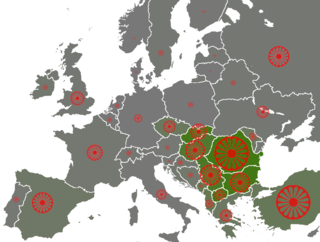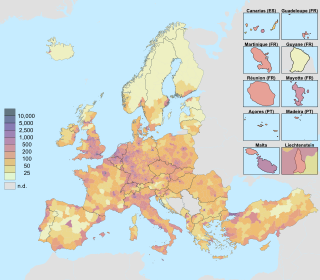
The Romani, also spelled Romany or Rromani and colloquially known as the Roma, are an ethnic group of Indo-Aryan origin who traditionally lived a nomadic, itinerant lifestyle. Linguistic and genetic evidence suggests that the Romani originated in the Indian subcontinent, in particular the region of present-day Rajasthan. Their subsequent westward migration, possibly in waves, is now believed by historians to have occurred around 1000 CE. Their original name is from the Sanskrit word डोम, ḍoma and means a member of the Dom caste of travelling musicians and dancers. The Roma population moved west into the Ghaznavid Empire and later into the Byzantine Empire. The Roma are thought to have arrived in Europe around the 13th to 14th century. Although they are widely dispersed, their most concentrated populations are located in Bulgaria, Hungary, Romania, Spain, and Turkey.

Demographic features of the population of the Czech Republic include population density, ethnicity, education level, health of the populace, economic status, and religious affiliations.

The demography of the Republic of Bulgaria is monitored by the National Statistical Institute of Bulgaria. Demographic features of the population of Bulgaria include population density, ethnicity, education level, health of the populace, economic status, religious affiliations and others.

The Romani Holocaust or the Romani genocide was the planned effort by Nazi Germany and its World War II allies and collaborators to commit ethnic cleansing and eventually genocide against European Roma and Sinti peoples during the Holocaust era.

Russians in the Baltic states is a broadly defined subgroup of the Russian diaspora who self-identify as ethnic Russians, or are citizens of Russia, and live in one of the three independent countries — Estonia, Latvia, and Lithuania — primarily the consequences of the USSR's forced population transfers during occupation. As of 2021, there were approximately 500,000 ethnic Russians in the three countries, having declined from ca 1.7 million in 1989, the year of the last census during the 1944–1991 Soviet occupation of the three Baltic countries.

Roma, traditionally Țigani, constitute one of Romania's largest minorities. According to the 2011 census, their number was 621,573 people or 3.3% of the total population, being the second-largest ethnic minority in Romania after Hungarians. There are different estimates about the size of the total population of people with Romani ancestry in Romania, varying from 4.6 per cent to over 10 percent of the population, because many people of Romani descent do not declare themselves Roma. For example, in 2007 the Council of Europe estimated that approximately 1.85 million Roma lived in Romania, based on an average between the lowest estimate and the highest estimate available at the time. This figure is equivalent to 8.32% of the population.
The Romani people, also referred to as Roma, Sinti, or Kale, depending on the subgroup, are an Indo-Aryan ethnic group that primarily lives in Europe. The Romani may have migrated from what is the modern Indian state of Rajasthan, migrating to the northwest around 250 BC. Their subsequent westward migration, possibly in waves, is now believed to have occurred beginning in about 500 AD. It has also been suggested that emigration from India may have taken place in the context of the raids by Mahmud of Ghazni. As these soldiers were defeated, they were moved west with their families into the Byzantine Empire.

Romani people in Bulgaria constitute Europe's densest Roma minority. The Romani people in Bulgaria may speak Bulgarian, Turkish or Romani, depending on the region.

Anti-Romani sentiment is a form of bigotry which consists of hostility, prejudice, discrimination, racism and xenophobia which is specifically directed at Romani people. Non-Romani itinerant groups in Europe such as the Yenish, Irish and Highland Travellers are frequently given the name "gypsy" and as a result, they are frequently confused with the Romani people. As a result, sentiments which were originally directed at the Romani people are also directed at other traveler groups and they are frequently referred to as "antigypsy" sentiments.

Romani people are an ethnic minority in the Czech Republic, currently making up 2–3% of the population. Originally migrants from North Western India sometime between the 6th and 11th centuries, they have long had a presence in the region. Since the creation of Czechoslovakia in 1918, the Romani population have experienced considerable hardship, having been a main target of Nazi extermination programs during World War II, and the subject of forced relocation, sterilisation, and other radical social policies during the Communist era. In the successor state, the Czech Republic, challenges remain for the Romani population with respect to education and poverty, and there are frequent tensions with the white majority population over issues including crime and integration.

The Romani people have several distinct populations, the largest being the Roma and the Calé, who reached Anatolia and the Balkans in the early 12th century, from a migration out of the Indian subcontinent beginning about 1st century – 2nd century AD. They settled in the areas of present-day Turkey, Greece, Serbia, Romania, Croatia, Moldova, Bulgaria, North Macedonia, Hungary, Albania, Kosovo, Bosnia and Herzegovina, Czech Republic, Slovenia and Slovakia, by order of volume, and Spain. From the Balkans, they migrated throughout Europe and, in the nineteenth and later centuries, to the Americas. The Roma population in the United States is estimated at more than one million.
According to the last census from 2021, there were 67,179 persons counted as Romani people in Slovakia, or 1.23% of the population. However, the number of Roma is usually underreported, with estimates placing the Roma population at 7-11% of the population. Thus the actual number of Roma may be over half a million.

Romani people in North Macedonia are one of the constitutional peoples of the country.

The demographics of the European Union show a highly populated, culturally diverse union of 27 member states. As of 1 January 2023, the population of the EU is around 448 million people.
Romani Americans are Americans who have full or partial Romani ancestry. It is estimated that there are one million Romani people in the United States. Though the Romani population in the United States has largely assimilated into American society, the largest concentrations are in Southern California, the Pacific Northwest, Southwestern United States, Texas, Louisiana, Florida and the Northeast as well as in cities such as Chicago and St. Louis.

According to the 2002 census, there were 3,246 Romani individuals living in Slovenia. They constitute 0.5 percent of the total population. The Slovenia Roma speak Balkan Romani and Italian. The Roma have been living in Slovenia since the 15th century.
The Romani, also spelled Romany or Rromani, colloquially known as the Roma, are an Indo-Aryan ethnic group who traditionally lived a nomadic, itinerant lifestyle.
The Romani, also spelled Romany or Rromani, colloquially known as the Roma, are an Indo-Aryan ethnic group who traditionally lived a nomadic, itinerant lifestyle.
The Romani, also spelled Romany or Rromani, colloquially known as the Roma, are an Indo-Aryan ethnic group who traditionally lived a nomadic, itinerant lifestyle.
Finland has a Romani population of approximately 10,000 to 12,000. Most Romani people in the country belong to the Finnish Kale subgroup and had settled in Finland at the end of the sixteenth century. Finnish Roma mostly live in Finland's urban areas. Although some of Finland’s Romani community still speak Kalo Romani, most Finnish Roma just speak only Finnish. In 1995, an amendment to the 1919 Constitution had granted the Romani people, Sámi people and other Finnish minorities, the right to retain and develop their own language and culture in Finland. The Finnish Kalo language has the status of a non-territorial minority language in Finland. Finland’s Romani community are also recognized as a national minority under the European Framework Convention for the Protection of National Minorities.












